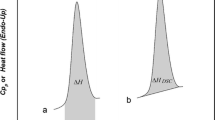Abstract
We have observed unique variations in AC electrical conductivity of solids when studied with respect to temperature, time, and frequency. A wide range of solids were examined for this study e.g., organics, polymers, carbohydrates, active pharmacy ingredients (APIs), and amino acids. The observed dielectric analysis conductivity for this great number of organic materials follows an Arrhenius plot of log polar ionic conductivity which is linearly related to reciprocal temperature and the correlation of coefficient is 0.992–0.999. These experimental observations support the polaron hopping conduction model. Experimental results clearly show novel dielectric behavior of a linear increase in a log ionic conductivity versus temperature in the pre-melt/solid-state transition regions. We have differentiated the solids which show the conductivity variations in pre-melt from those which do not. Isothermal dielectric analysis was used to study the cause of this variation in solids which yielded the measure of behavior, i.e., the polarization time property. We have also studied the effect of various experimental factors (e.g., moisture and purity) on the results. Correlating dielectric with calorimetric analyses gave us a better understanding of solid-state properties. Calorimetric analysis was used to assure that the observed variations in the solid-state properties are not due to moisture or impurities present in the sample. The ASTM E698 “purity method” was employed to verify the purity of the chemicals. Activation energies were calculated based on Arrhenius behavior to better interpret the solid-state properties. As the different chemicals were heat–cool cycled they were more amorphous, as evidenced by the decreasing activation energy for charge transfer with an increasing amorphous content.










Similar content being viewed by others
References
Andrew Jonscher K. Dielectric relaxation in solids. J Phys D. 1999;32(14):R57.
Riga A, Kenneth Alexander S. Electrical conductivity analysis/dielectric analysis differentiate physical chemical properties of drugs and excipients. Am Pharm Rev. 2005;8(6):45–51.
Mantheni DR, Maheswaram MPK, Perera N, Sobhi H, Riga AT, Alexander K. Solid state studies of dielectric and calorimetric analysis. J Therm Anal Calorim. 2012;108(1):227–33.
Tataroglu A, Yucedag I, Antildal S. Dielectrical properties and electrical properties of MIS type Schottky diodes at high temperatures. Microelectron Eng. 2008;85(7):1518–23.
Andonovska N, Rendevski S, Prendzov S. Temperature dependence of electrical conductivity of polyvinyl chloride-barium titanate composite. Bull Chem Technol Maced. 2002;22(1):17–22.
Perera I, Maheswaram MPK, Mantheni D, Riga AT. Dielectric analysis of response time in electro-rheological fluids developed for medical devices. Ameri J Anal Chem. 2011;2:85–92.
Matthews E, Riga A. Effect of thermal history on solid state and melting behavior of amino acids. J Therm Anal Calorim. 2009;96(3):673–6.
Riga AT, The electrochemical and dissolution properties of nickel oxide. PhD dissertation, Department of Chemistry, Case Western Reserve University, Cleveland, Ohio, Feb 1967, pp 33–35.
Ziman JM. Formal transport theory in electrons and phonons the theory of transport phenomenon in solids. New York: Oxford University Press; 1963. p. 208.
Riga AT. Heat distortion and mechanical properties of polymers by thermomechanical analysis. J Poly Eng Sci. 1974;14(11):764–7.
Riga AT, Cahoon JM, Pialet JW. Characterization of electrorheological process by dielectric thermal analysis. In: Riga AT, Judovits L, editors. Materials characterization by dynamic and modulated thermal analytical techniques. Conshohocken: ASTM STP 1420; 2001. p. 147–55.
Brennan WP, DiVito MP, Fyans RL, Gray AP. An overview of the calorimetric purity measurement. In: Blaine S, editor. Purity determinations by thermal methods. Hopeland: ASTM STP 838; 1983. p. 5–15.
American Society for Testing and Materials. Standard test method for purity by differential scanning calorimetry, E928, W Conshohocken, PA, 2008.
Author information
Authors and Affiliations
Corresponding author
Rights and permissions
About this article
Cite this article
Mantheni, D.R., Maheswaram, M.P.K., Munigeti, R. et al. Solid- and liquid-state studies of a wide range of chemicals by isothermal and scanning dielectric thermal analysis. J Therm Anal Calorim 115, 2253–2260 (2014). https://doi.org/10.1007/s10973-013-3304-z
Received:
Accepted:
Published:
Issue Date:
DOI: https://doi.org/10.1007/s10973-013-3304-z




